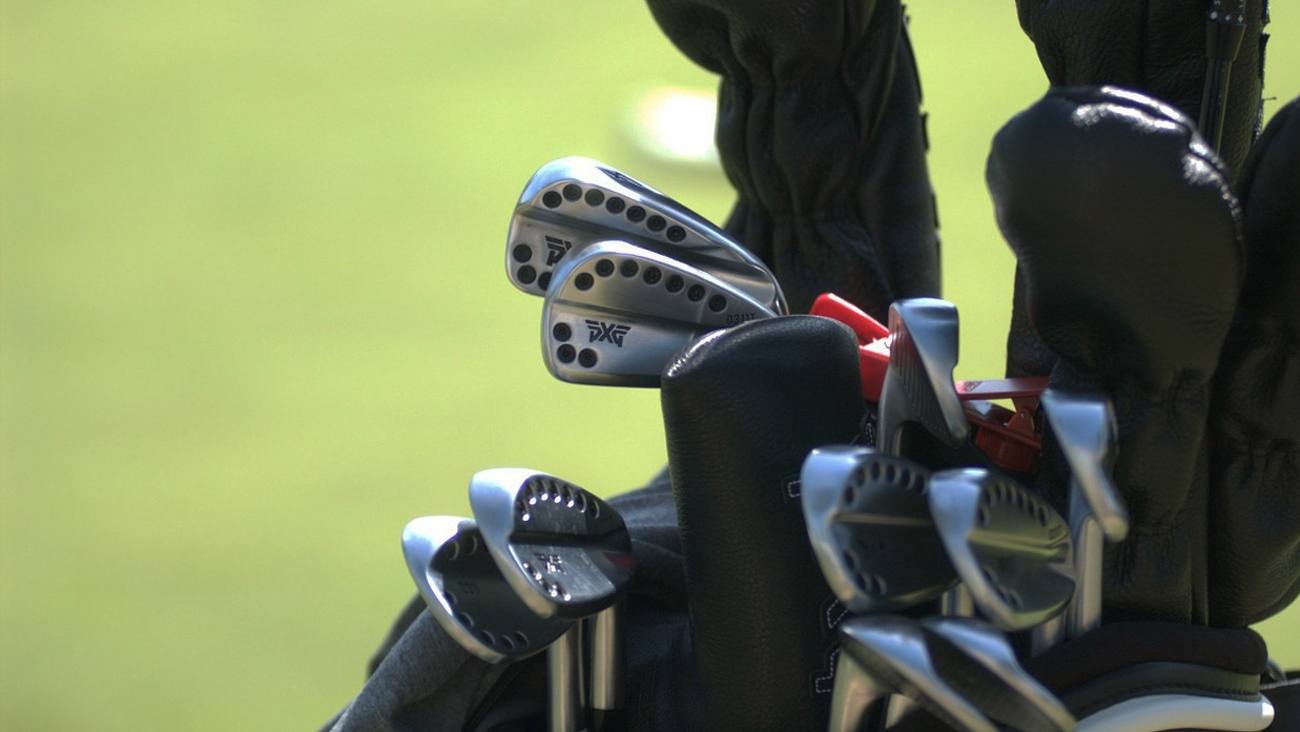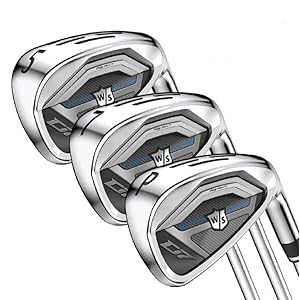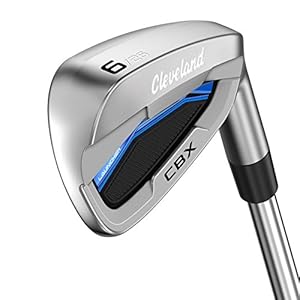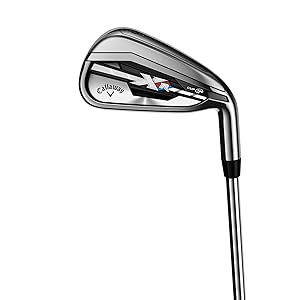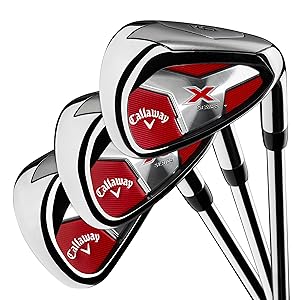With no official definition of “mid handicap” it can be challenging to grasp the level of player the term describes. If you’re a mid handicap player, chances are you’ve smashed the beginner goal of breaking 100, and are now scoring between 85 and 95 every round.
If you’re playing at a mid handicap, it might be time to upgrade your equipment. Some players start out with a decent enough set of clubs, while others pick up something cheap and cheerful to use while they get a feel for the game. Either way, if you’ve found your way here, we’re guessing you’re looking to pick up a set of irons that are suitable for your handicap.
- 1 Best Golf Irons for Mid Handicappers
- 2 Callaway Golf Men’s Rogue Irons
- 3 Wilson Staff Golf Men’s D7 Irons
- 4 TaylorMade Golf P790 Men’s Irons
- 5 Callaway Men’s XR Irons
- 6 Callaway Golf Men’s X-Series Irons
- 7 Cleveland Golf Men’s Launcher CBX Irons
- 8 When is the Right Time to Invest in Mid Handicap Irons
- 8.1 Shafts
- 8.1.1 Irons with Steel Shafts
- 8.1.2 Irons with Graphite Shafts
- 8.2 Flex
- 8.3 Golf Iron Club Heads
- 8.4 Muscle Back Irons and Cavity Back Irons
- 8.1 Shafts
- 9 Final Thoughts on Golf Irons for Mid Handicappers
Best Golf Irons for Mid Handicappers
We’ve put together a list of what we consider to be excellent golf irons. Their quality means they’ll last you well into low single digits. They’re advanced enough to help with ball speed, distances and not to mention forgiving enough to soften the occasional mishit.
Here’s 6 of our top rated irons for mid handicappers to improve consistency and better your game.
Callaway Golf Men’s Rogue Irons
These Callaway Rogue Irons make an excellent choice and sit at a well deserved first place on our list. With an eye-catching black and metal design, they look tremendous. Looks aside, we’re very excited by the technical side of the clubs. VFT (variable face thickness) technology means the part of the face delivering fast club speed gets expanded. Tungsten, a material twice as heavy as steel provides the weighting, this allows significant weight concentration into a small space. The precision weight distribution means you get optimal launch and control of the club.
If you’re tired of vibrations darting up the shaft, you’ll be pleased to learn these clubs work to counter them. They use elastic-urethane microspheres, which give you sound and vibration reduction without compromising ball speed or COR as regular urethane often does. These clubs will cater to most mid-handicappers regardless of orientation or preference, available for left and right-handers and with a choice in shaft material and flex. Overall these are a top quality set of irons, which we consider to be our overall best rated golf irons for mid handicappers.
Wilson Staff Golf Men’s D7 Irons
If you’re a fan of Wilson, you’ll be pleased to see the excellent D7 irons featuring in our round-up. These clubs help add consistency, as well as the distance many mid handicappers are looking to add to their game. Distance is maximized through the longer irons using Wilsons Power Holes. The clubface is just the right size to make players struggling with precision feel confident they’ll strike the ball well.
Not only do these feel great to play with, the clean and piercing lines mean they look great in your bag. This set of clubs is really well suited to anyone looking for a forgiving clubface designed to give you extra distance.
TaylorMade Golf P790 Men’s Irons
Are you looking for a set of irons that have thin faces but aren’t quite blades? Look no further than the TaylorMade P790 irons which are an impressive 1.75 millimeters thin. Despite the ultra-thin clubface, there’s no disputing that these clubs pack a real punch. They’re made using high strength forged 4140 carbon steel. The thin yet robust construction make these a real beauty to swing and don’t be surprised if you see a 10-15 yard jump in your distances. SpeedFoam gives these a soft touch as well as responsive feedback.
Tungsten placement adds an imperative edge to these golf clubs, which balanced with the hollow construction makes for beautiful strikes of the ball. You should find these suitable regardless of what you’re looking for in a set of irons. You get a choice between left and right-handed clubs, steel or graphite shafts and four different flex options.
Callaway Men’s XR Irons
If you’re new to golf, you’ll love what these clubs bring to your game. Often people starting out will struggle to get that much-needed lift when they connect with the ball. These clubs have a lowered center of gravity that adds height as well as distance to your swings. The 360 Cup technology improves the length of your shots, acting as a spring for connections made low on the face.
You’ll be impressed with how forgiving these clubs are. Even if you strike the ball slightly off center, you’ll be surprised with the line you maintain. You get a choice between graphite and steel shafts, regular or stiff flex and the irons are available for right or left-handed golfers. So, if you’re relatively new to the game and are looking for a quality set of irons, these come highly recommended.
Callaway Golf Men’s X-Series Irons
If you’re looking for a forgiving club with a particular emphasis on increased distance and speed, these make an excellent choice. The Callaway X-Series come equipped with cavity back design distance technology, helping you get that extra few yards you might be looking for.
The impressive design allows the entire face to be that little bit more forgiving, giving you that little bit of leeway should you slightly miss hit the ball. You get a choice between graphite and steel shafts, a senior or stiff flex and left or right-handed orientation. Overall these are a very nice set of clubs that look the part and feel great to use.
Cleveland Golf Men’s Launcher CBX Irons
The excellent Cleveland CBX range is the first set of irons they’ve produced for a few years, and we feel they were definitely worth the wait. These bring excellent control to your game, combined with distance and loft. Cup face technology makes for excellent ball speed. The cavity design comes with perimeter weighting helping you maintain ball speed even when you don’t make the cleanest of strikes.
The versatile Dual V-sole design of the irons give you extra forgiveness and Feel Balancing technology brings the center of gravity towards to middle of the clubface for improved connection with the ball. Like the other clubs in the review, you get a choice of shaft material, flex as well as left or right-hand orientation.
When is the Right Time to Invest in Mid Handicap Irons

If you think the best time to invest in mid handicap irons is when you reach a mid handicap, it’s not quite that simple. Not everyone at this level of playing ability has the same goals for their game. You’ll find some people only ever consider golf a casual past time. If you’re this kind of player, then chances are you might avoid making the step up, and stick with the golf clubs you started with. After all, a new set of irons are an investment and one that you should get good use out of.
On the other hand, players who are looking to invest in a new set of clubs need to know when the time is right. If you find yourself sick of the sight of your club faces, it might be time to freshen your set up. If you’re not happy with your equipment, it’s likely to hurt your game. In this case, It’s not uncommon to associate your bad shots with your clubs rather than your technique. Below we’ll run through each part of golf irons to help you understand what to look for when buying a set.
Shafts
The golf shaft is a long cylindrical tube connecting your handle to the head of your club. Although it doesn’t quite have the intricate detailing associated with club heads, it plays an equally important role. The shaft allows you to generate the range of movement required to connect with the golf ball at force. When it comes to buying irons, you’ll notice that more often than not, you get a choice between steel and graphite shafts.
Irons with Steel Shafts
With steel being the heavier of the two shaft types, players who swing at high speeds should expect better results. The additional weight behind the swing will help your shot travel further on the connection, but also feel more resistant during the swinging motion. This resistance should help to give your golf swing more overall control.
Steel shafts are often favorable with golfers who prefer high feedback on their connection with the ball. With a steel shaft, you’ll feel strong vibrations up the shaft. These vibrations can often be frustrating for newer players. However, more skilled players can use these vibrations to get a better understanding of their impact with the ball.
Irons with Graphite Shafts
Graphite shafts are the lighter option. These might be some help to you if you’re struggling with slow swing speeds. The improvement in your swing speed should mean you also see an increase in your distance. If you’re carrying an injury, and find vibration up the shaft brings you pain, graphite shafts could be preferable. They help to muffle the vibrations helping to make them a lot more manageable.
You’ll also find that graphite shafts are a lot less rigid when compared to steel shafts. It’s unclear whether this is a benefit or not, and it ultimately depends on the player. You’ll find the increased flexibility is almost exaggerated; players with a good swing can find their shots getting even better, and players with a bad swing might end up with even worse shots.
Graphite shafts can undoubtedly bring benefits to a players game, but also tend to have a slightly higher price tag. Balancing the expected benefits graphite shafts would bring to your game against the increased cost of the set should help you to make your decision.
Flex
If you’ve noticed that you get a choice between shaft materials, you might have also seen you get a choice when it comes to shaft flex. The term flex refers to how much flexibility there is in the shaft. With a stiff shaft proving a lot more difficult to bend compared to a regular shaft.
We’d recommend dropping by the pro shop next time you’re at the range and asking if you can test out a few clubs with a different variety of shaft flex. Be careful though, don’t let yourself feel pressured into buying anything there and then. Always check the clubs out online to see if you can find yourself a lower price.
Golf Iron Club Heads
The club head has multiple parts, the hosel at the top which connects the head of your club to the shaft. One of the most talked about components being the clubface, which is the part of your club that makes physical contact with the ball.
Underneath the clubface, you’ve got the part of the club that makes contact with the ground which is called the sole. Lastly, you’ve got the rear of the club is called the back. For mid handicap irons, one of the most important decisions you’ll make is your choice between the muscle back and cavity back iron.
Muscle Back Irons and Cavity Back Irons

Muscle back irons have evolved from the traditional blades, which were very thin and harder to hit the ball with. These types of iron are better suited to those players looking to master shaping their shots. If you’re looking to have more control over your fades and draws this type of iron is best suited to you.
Cavity back irons are much more forgiving and feel a lot easier to make a connection with the ball. What you lack with these clubs is the ability to shape shots as well as you can with a muscle back iron. That said, at a mid-handicap level this shouldn’t be your priority.
As technology advances, so does the ability to play more technical shots with cavity back irons, which is why you’ll notice more and more pros using them. Just like teeth, a club with a cavity has part of it missing. If you see an iron that looks like it’s missing a piece from the back, you can be sure that’s a cavity back iron.
Our view is that most mid-handicap golfers would be best suited to a cavity back iron, rather than a muscle back. This is due to cavity back irons ability to provide more consistency than muscle back irons. At a mid-handicap level, consistency is key to taking your game to the next level.
Final Thoughts on Golf Irons for Mid Handicappers
Investing in a set of mid-handicap irons could be a smart move if you’re at a point where you’re looking to take your game up a notch. Remember, you need to understand which type of irons you’re looking for before making your purchase.
You’ll need to have an understanding of the right kind of shaft (steel or graphite) for you, as well as the amount of flexibility it has. You’ll also need to decide between a muscle back and a cavity back iron. We’d recommend you go for the cavity back if you’re looking to become more consistent.
